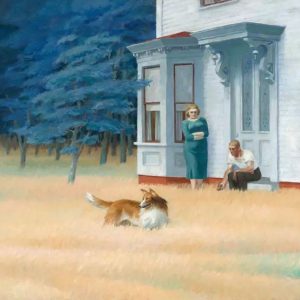Spot the dog – a game for all ages
Jonathan Self
‘Your children are beautifully behaved,’ said the Uffizi tour guide, an hour into our tour, ‘so interested, so polite. If only our adult visitors,’ he sighed, ‘were as mannerly.’ This happened eight years ago when the twins were just ten years old. At the time Charlotte, who has had the poise of a career diplomat ever since she was a baby, smiled angelically. Oliver, her twin brother, asked if we could visit room 27 as he wished to check a detail from Pontormo’s Supper at Emmaus. He called the guide dottore earning himself, when the man had turned away, a sisterly jab, which he countered with a brotherly shove.
The twins were engaged in a particularly tense round of a game I invented for them called ‘Spot the Dog’. The rules are simple. Visit any museum, gallery, place of worship or country house and look for works of art that incorporate, in some way, a dog or dogs. If you are playing a friendly match then give yourself a point for every dog you spot, even if another player spotted him or her first. If, on the other paw, you are participating in a championship then dogs can’t be counted twice. The wise player photographs each dog spotted, as it is not unknown for games to end in acrimony and/or a steward’s inquiry.
As a way of encouraging children to take an interest in art (or simply to stem the tide of complaint that can arise when younger members of the family suffer culture overload of the ‘not another museum’ variety, ‘Spot the Dog’ cannot be beat. Moreover, the game has a scholarly side to it.
No one really knows when humans and dogs decided to live together. An analysis of mitochondrial DNA suggests that the origin of dogs can be traced back 135,000 years and the oldest dog remains to be found so far (in southern Siberia) can be dated to 33,000 years ago. In the Chauvet Cave in France there exist 26,000-year-old bare footprints left by a small, torch-bearing child and, endearingly, the paw prints of his canine companion.
What we can be certain of is that, ever since our early ancestors began to draw, paint and decorate, dogs have been as popular a subject as people. Indeed, there are prehistoric Somalian cave paintings of dogs that may be 12,000 years old, a Mesopotamian statue of a dog (now in the Louvre) that could be 5,000 years old and, in Tutankhamun’s tomb, a relief panel in solid gold featuring a running, barking dog that is around 3,000 years old.
In the same way that dogs slowly and carefully insinuated themselves into our lives (and hearts), allowing us to believe in the process that we were ‘domesticating’ them, they insinuated themselves into our art.
From the beginning they have been accorded the same creative treatment as humans. That is to say, sometimes they are merely figures in the background, part of the general scene but not central to it. These are the dogs you see crouching under a table, lying on a mistress’s bed or participating in a hunt. On other occasions, however, dogs take (and when one thinks of their personalities this isn’t so surprising) centre stage. These are the dogs who were sculpted in Ancient Rome, celebrated by medieval craftsmen and had their portraits executed by famous Victorian painters.
Various themes run through the history of dog art, many of which can be traced back to ancient times. From the Greeks we get the idea of the dog as a loyal, faithful animal that never, ever deserts his master. This concept was made popular in the first instance by Homer who, in The Odyssey, writes of how, on Odysseus’ return to Ithaca, only his old dog, Argos, recognises him. From the Romans, who kept three kinds of dogs – hunting dogs, guard dogs and companion dogs – we inherit a way of classifying all dog art.
Some of the best dog art appears in the most unlikely of places. I remember looking up at the 12th century frescoed ceiling of the Panteon de los Reyes de la Basilica in the Colgiata de San Isidoro in Leon, Spain and finding, to my surprise, that the most dominant element was a giant guard dog being fed by its owner under the watchful eyes of the archangel Gabriel. In fact, dogs are frequently featured in Christian art, appearing in endless visions (The Vision of St Eustachius by Durer, The Vision of St Augustine by Carpaccio &c.) as well as being present at major Biblical events (The Nativity by da Siena, The Last Supper by Lorenzetti &c.) and even in the margins of illuminated manuscripts (The Book of Kells, The Rochester Bestiary, &c.).
Another good source of material for ‘Spot the Dog’ participants are portraits. Ever since man first developed the urge to be immortalised in paint (or some other medium), he has included his four-legged companion in the resulting compositions. When the Duke of Mantua commissioned a portrait from Titian (c.1525) he decided to be shown petting his favourite dog. This served a second purpose, which was to tell the viewer what sort of a man the duke was. Dogs offer artists ample opportunity to highlight aspects of a subject’s personality, add a narrative, explain their status or imply some emotion.
It says everything about the closeness that exists between men and dogs that the latter don’t even need to be present to educate and entertain the former. All that is required is a picture. Percy Bysshe Shelley got it only half-right when he said: ‘The psychological and moral comfort of a presence at once humble and understanding — this is the greatest benefit that the dog has bestowed upon man.’ Another great benefit is that they have given the twins and me ‘Spot the Dog’.
